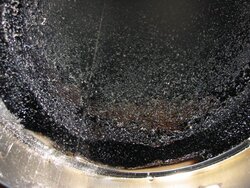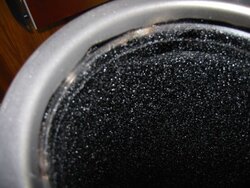Check out the picks of the creosote in my stove pipe and chimney pipe, after about 2 weeks of newbie burning in my new Oakwood.
I have always suspected the moisture content of the wood I'm burning, but the stove WILL run away with the wood if I get a good bed of coals, and peg the stovetop thermo at or above 600 if I let it. At this time of year, a 500 deg burn for any length of time cooks us out of the room it's in (although the cats like it), so I try to maintain it at around 400.
But overnight, when I try to slow it down for an overnight burn, it will drop down to 350 and hover there. Is this too low for a burn without creosote buildup? At these overnight temps, my front door glass blacks over really fast, although I don't take precautions to keep the wood away from the glass.
Does the visible creosote warrant cleaning this soon, or could I minimize/reduce it by doing hoter, longer burns?
ALSO, I just noticed streaky creosote drips running down the top 5' of the EXTERIOR of my nice, shiny stainless chimney. Is this at all normal, and will it go away, or do I have to go up there and risk my neck and clean it off?
BTW, I've begun paying attention to the smoke coming out of my chimney, and at a 400 deg burn, I can regularly get a zero or low-smoke condition.
I have always suspected the moisture content of the wood I'm burning, but the stove WILL run away with the wood if I get a good bed of coals, and peg the stovetop thermo at or above 600 if I let it. At this time of year, a 500 deg burn for any length of time cooks us out of the room it's in (although the cats like it), so I try to maintain it at around 400.
But overnight, when I try to slow it down for an overnight burn, it will drop down to 350 and hover there. Is this too low for a burn without creosote buildup? At these overnight temps, my front door glass blacks over really fast, although I don't take precautions to keep the wood away from the glass.
Does the visible creosote warrant cleaning this soon, or could I minimize/reduce it by doing hoter, longer burns?
ALSO, I just noticed streaky creosote drips running down the top 5' of the EXTERIOR of my nice, shiny stainless chimney. Is this at all normal, and will it go away, or do I have to go up there and risk my neck and clean it off?
BTW, I've begun paying attention to the smoke coming out of my chimney, and at a 400 deg burn, I can regularly get a zero or low-smoke condition.



